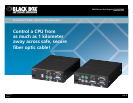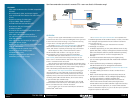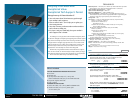
724-746-5500 blackbox.com
BL A C K B O X
®
3 of 4
01/29/2010
#26573
The ServSwitch Fiber Optic KVM Extenders‘ keyboard
and mouse interfaces are standard PS/2
®
type interfaces, so you
can attach just about any standard PS/2 compatible keyboard and
mouse to the unit. To attach a PC/AT
®
style keyboard with a 5-pin
DIN connector to the extender, you’ll need a keyboard adapter (to
order,callourFREETechSupport).
The extenders come with zip-style cable for making VGA
connections to your server; the audio/serial model comes with
serial and audio CPU cables, too.
For monitoring operation, the remote module has a seven-
segment display that contin uously indicates link status. In addition,
DeviceReadyLEDsonbothlocalandremoteunitsinformyouof
their operational status, so you can trouble shoot at either end.
The ServSwitch Fiber Optic KVM Extenders support all
VGA graphics cards and VGA resolutions up to 1280 x 1024 @ 75
Hz.YoucanusethemtotransferRGBaswellasVGA(RGBVH)
signalsand,ifnecessary,convertsignalstotransferRGBtoVGA
orfromVGAtoRGB.Allyouhavetodoismakeasimplejumper
adjustment on the extenders’ motherboards.
There’s no need to worry about the video getting horribly
distorted at either end of the fiber optic link. By default, the KVM
extenders operate with an automatic gain control (AGC) function
enabled. With AGC enabled, the gain of each color signal is fixed
to give colors the same white level (0.7 Vpp), and most video
problems are cleaned up automatically.
In some applications, it may be necessary to switch off
the AGC so you can optimize video (to remedy a chromatic
aberration, for instance). For this, you just need to flip internal
jumpers and tweak the manual brightness and contrast
potentiometer dials on the rear panel of each unit. You can also
attenuate the optic budget to raise the optical loss to a value that
corrects any unstable image. (To do this, you need fiber pigtail
couplingconnectors.Fordetails,callourFREETechSupport.)
The seven-segment display aids with troubleshooting video
gain. For instance, if it shows an ”F,” you’ve adjusted the contrast
on the unit too high and, with AGC no longer possible, you need
to readjust the gain.
Extend serial data and stereo audio, too.
ToaddRS-232serialandaudioextensioncapabilitiestoyour
KVM-over-fiber extender application, order the ACS335A-AS
version of the ServSwitch Fiber Optic KVM Extender. The circuit
boards on its local and remote units support transmitting
bidirectional stereo audio and full-duplex 19-kbps serial data
across the interconnecting fiber cable.
The serial ports on the ACS335A-AS support extending TX,
RX,RTS,CTS,DTR,andDSRserialsignals(and,insomecases,RI
and DCD signals, for which a wiring adapter may be required.)
You can connect either one serial device requiring hardware
handshaking or—using breakout cable—up to three simple
2-wireserialdevices(TX/RXonly).Nouseradjustmentsare
required for the serial connection.
For multimedia capability, connect a set of speakers or a
headset or microphone to a workstation linked to the remote
unit. The extenders transmit stereo audio bidirectionally and
simultaneously across the fiber cable link. The extender local
unit sends audio digitally (as part of a 16-bit, 38.4-KHz signal)
for near-CD sound quality at the remote end of the fiber
interconnection.
The line-level interface is designed to receive output from
a sound card or other line-level source and connect to a set
of powered speakers at the remote console. No further setup is
required unless a microphone is connected to the remote unit (in
which case, you just need to ensure that your sound card is set up
and wired to provide sufficient amplification).
Technically Speaking






